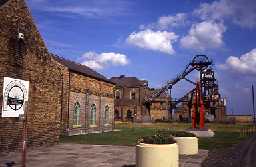Woodhorn Colliery (Ashington)
Woodhorn Colliery was established in 1894 by the Ashington Coal Company and produced its first coal in 1901. At its height, in the early 20th century, over 2000 workers were employed there. It was one of more than 200 mines in Northumberland. The buildings are built from local Ashington brick and include, two shafts with headgear and winding houses, fan and engine houses, workshops and a stable. The colliery started to decline in the 1960s with the availability of cheaper alternative fuels, such as oil and gas, and closed in 1981. The colliery was turned into a museum in 1989. The buildings which survive today are rare survivals of a once widespread industry. The engine houses, with headgear in front, were an increasingly common feature during the 20th century but those at Woodhorn are of particularly high quality. Many of the buildings are Grade II* and Grade II Listed Buildings protected by law and part of the colliery is a Scheduled Monument, also protected by law.
N11679
Victorian (1837 to 1901)
Late 20th Century (1967 to 2000)
Late 20th Century (1967 to 2000)
WATCHING BRIEF, Archaeological watching brief at Woodhorn Colliery 2001; THE ARCHAEOLOGICAL PRACTICE
DESK BASED ASSESSMENT, Woodhorn Colliery 2001; Cranstone Consultants
ARCHITECTURAL SURVEY, Woodhorn Colliery 2003; Mason Land Surveys Ltd
PHOTOGRAPHIC SURVEY, Woodhorn Colliery, Wansbeck, Northumberland. Record survey 2006; RMJM
DESK BASED ASSESSMENT, Woodhorn Colliery 2001; Cranstone Consultants
ARCHITECTURAL SURVEY, Woodhorn Colliery 2003; Mason Land Surveys Ltd
PHOTOGRAPHIC SURVEY, Woodhorn Colliery, Wansbeck, Northumberland. Record survey 2006; RMJM
Disclaimer -
Please note that this information has been compiled from a number of different sources. Durham County Council and Northumberland County Council can accept no responsibility for any inaccuracy contained therein. If you wish to use/copy any of the images, please ensure that you read the Copyright information provided.
